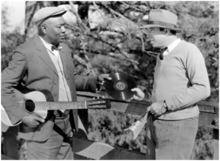Jim Jackson (musician)
Jim Jackson | |
|---|---|
 Jackson (left) and King Vidor on the set of the film Hallelujah! | |
| Background information | |
| Born | June 1876 Hernando, Mississippi, United States |
| Died | December 18, 1933 (aged 57) Memphis, Tennessee, United States |
| Genres | Blues, hokum |
| Instruments | Guitar |
| Years active | 1905–1933 |
Jim Jackson (June 1876 – December 18, 1933)[1] was an American blues and hokum singer, songster, and guitarist, whose recordings in the late 1920s were popular and influential on later musicians.
Biography[]
Jackson was born in Hernando, Mississippi.[2] The researchers Bob Eagle and Eric LeBlanc date his birth as 1876,[1] but other sources give 1884 or 1890.[2] He was raised on a farm, where he learned to play guitar. Around 1905 he started working as a singer, dancer, and musician in medicine shows and played at dances and parties, often with other local musicians, such as Gus Cannon, Frank Stokes and Robert Wilkins.[2] He soon began travelling with the Rabbit Foot Minstrels, featuring Ma Rainey and Bessie Smith, and other minstrel shows.
He also played in clubs on Beale Street in Memphis, Tennessee. His popularity and proficiency secured him a residency at the prestigious Peabody Hotel in Memphis in 1919. Like Lead Belly, Jackson knew hundreds of songs, including blues, ballads, vaudeville numbers, and traditional tunes, and became a popular attraction.
In 1927 the talent scout H. C. Speir obtained for him a recording contract with Vocalion Records. On October 10, 1927, he recorded "Jim Jackson's Kansas City Blues",[3] which became a best-seller.[4] Its melody and lyrics can be traced in many later blues and rock and roll songs, including "Rock Around the Clock" and "Kansas City". Following this hit Jackson recorded a series of "Kansas City" follow-ups and soundalikes.[4] Other artists recorded cover versions of the song (including William Harris in 1928[5]) and reworked it (as Charlie Patton did, changing it to "Gonna Move to Alabama."[6]) Jackson moved to Memphis in 1928 and made a series of further recordings, including the comic medicine show song "I Heard the Voice of a Pork Chop".[7] He also appeared in King Vidor's all-black 1929 film Hallelujah!; it is unclear what role he played.[2]
Jackson ran the Red Rose Minstrels, a travelling medicine show which toured Mississippi, Arkansas and Alabama. As a talent scout for Brunswick Records, he discovered Rufus "Speckled Red" Perryman, gaining him his first recording session.[8] Shortly afterwards, in February 1930, Jackson recorded his last session. He later moved back to Hernando and continued to perform until his death in 1933.
Legacy[]
Janis Joplin later recorded a version of "Kansas City Blues", inserting the lyrics "Babe, I'm leavin', yeah I'm a-leavin' this mornin' / Goin' to Kansas City to bring Jim Jackson home".[9]
Jackson was a major influence on the Chicago bluesman J. B. Lenoir. Jackson's "Kansas City Blues" was a regular fixture of Robert Nighthawk's concert set list.[2] Brownie McGhee said "Kansas City Blues" was "the first tune that I ever learned to play." (Seattle Folklore Society video).
The song "Wild About My Lovin'" was covered by the Lovin' Spoonful and released on their 1965 debut album, Do You Believe in Magic.
See also[]
- List of blues musicians
- First rock and roll record
Recommended recording[]
- Jim Jackson Vols. 1–2 (Document Records)[6]
References[]
- ^ Jump up to: a b Eagle, Bob; LeBlanc, Eric S. (2013). Blues: A Regional Experience. Santa Barbara, California: Praeger. p. 516. ISBN 978-0313344237.
- ^ Jump up to: a b c d e "Jim Jackson: Biography". AllMusic. Retrieved August 30, 2015.
- ^ Russell, Tony (1997). The Blues: From Robert Johnson to Robert Cray. Dubai: Carlton Books. p. 12. ISBN 1-85868-255-X.
- ^ Jump up to: a b Giles Oakley (1997). The Devil's Music. Da Capo Press. p. 139. ISBN 978-0-306-80743-5.
- ^ "William Harris". Thebluestrail.com. Retrieved January 7, 2017.
- ^ Jump up to: a b Russell (1997). The Blues: From Robert Johnson to Robert Cray. Dubai: Carlton Books. p. 121. ISBN 1-85868-255-X.
- ^ Colin Larkin, ed. (1995). The Guinness Who's Who of Blues (Second ed.). Guinness Publishing. p. 194. ISBN 0-85112-673-1.
- ^ Silvester, Peter J. (1989). A Left Hand Like God: A History of Boogie-Woogie Piano. pp. 112–113. Da Capo Press. ISBN 978-0306803598.
- ^ "Janis Joplin, Kansas City Blues Lyrics". MetroLyrics. Retrieved July 25, 2016.
External links[]
- 1876 births
- 1933 deaths
- African-American guitarists
- American blues guitarists
- American male guitarists
- American blues singers
- Songster musicians
- People from Hernando, Mississippi
- Blues musicians from Mississippi
- RCA Victor artists
- Vocalion Records artists
- Guitarists from Mississippi